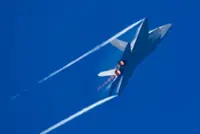Dinosaur feathers found trapped in Burmese amber have shed new light on the evolution of flight feathers, an essential step that allowed early birds to surpass their dinosaur relatives in conquering the skies, a Chinese study has found.
Through a detailed structural study of feathers dating back 99 million years to the Cretaceous period (145 to 66 million years), the researchers were able to gain insight into how feathers evolved during this era.
“Feathers are critical for the flight of birds,” the team led by researchers from the Chinese Academy of Sciences (CAS) said in a paper published in the peer-reviewed journal Science Bulletin on May 13.
An essential feature of the evolution of birds was the development of feathers that helped generate thrust and lift.
While modern birds are the direct descendants of dinosaurs, scientists believe that most feathered dinosaurs in the ancient world did not have the same ability to fly, though there has been evidence that some species could glide or have powered flight.
When most people picture flying dinosaurs, the creatures they imagine with large, fleshy wings are actually non-dinosaur reptiles that lived in the same era, such as the pterosaurs.
The evolution of feathers was an essential part of the evolution from birdlike dinosaurs to the first real birds, though studying this has been difficult as feathers are poorly preserved in the fossil record.
Fossils preserved in amber offer a unique opportunity to study soft structures, as objects stuck in the hardened tree resin remain trapped in time.
The team was able to obtain three-dimensional structural information about the feathers, providing new evidence for stages in feather evolution and helping to reconstruct the evolutionary path that led to the flight ability of early birds.
A feather consists of the rachis, the central shaft of the feather, and two rows of barbs or branches on either side. Each barb also features a row of hairlike barbules on each side.
In modern flying birds, the barbules on one side have tiny hooks, while the barbules on the other side have grooves that latch together like Velcro.
This creates an interlocking hook-and-groove mechanism that forms a strong, airtight surface that is resistant to the tearing force of the air during flight.
The hooklets and spines on the tip of barbules also form an additional locking mechanism called the slide-lock system, which was first described by CAS researchers several years ago.
“These synergistic mechanisms provide bird feathers with super durability and high self-repairing capability,” the researchers said.
Current evolutionary models include five feather developmental stages, with the development of the barbules occurring in stage three and the interlocking mechanism appearing in stage four.
“However, the information regarding the evolution of the barbs and barbules [from stage three to stage four] is limited due to challenges in preserving these ultrastructures during fossilisation,” the team said.
Some feathers found in Cretaceous amber have had identifiable hooks, but it remains unclear whether they also had corresponding grooves, meaning there was no direct evidence for the evolutionary history behind the locking mechanisms.
When examining two types of feathers found in the Burmese amber, designated as Type I and II, the team classified them as belonging to stage three and stage four, respectively.
The Type I feathers are more similar to primitive feathers found in non-avian theropods – or three-toed dinosaurs – than modern birds, with slightly curved barbules and no hook-groove mechanism.
The Type II feathers had a thicker rachis and asymmetrical barbules like those of modern flight feathers, with clear grooves and hooks that formed an interlocking mechanism. The shape of the barbules would have allowed air to pass through, suggesting weak aerodynamic performance.
The team also found nodules on the barbules of one specimen, which are the oldest evidence of the slide-lock system in feathers to date.
“This discovery provides the first evidence that, besides the hook-and-groove mechanism, the slide-lock system was also present during the Cretaceous,” the team said.
Their findings indicated that stage four of feather evolution could be divided into two parts: the first with the hook mechanism absent, and the second in which the hooking mechanism and slide-lock mechanism were present.
The team also studied melanosomes – the organelles of pigment cells that store melanin – in the Cretaceous feathers and found that the Type I feathers were probably black with a red lustre, while the Type II feathers were a grey or “penguin-like” black colour. - SOUTH CHINA MORNING POST





